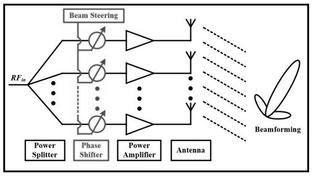RF Front end Vs back end : Key differences
Advertisement
The RF (Radio Frequency) front end refers to the portion of a communication device that handles the transmission and reception of RF signals using an antenna. It represents the initial stages of a wireless system where signals from the environment (such as airwaves) are received and processed.
The RF front end includes components that handle the conversion of analog RF signals to digital signals and vice versa. This conversion enables effective communication between mobile devices and cellular towers.
Key RF Front End Components
The key RF front end components used in cellular and wireless systems are as follows:
- Antennas: Responsible for transmitting and receiving radio signals. They convert electrical signals into EM waves for transmission and vice versa for reception.
- Duplexers: Allow the use of a single antenna for transmission and reception using the same frequency band.
- Filters: Used to isolate and separate signals within specific frequency ranges, ensuring that the desired frequency band is transmitted or received.
- Low Noise Amplifier (LNA): Amplifies weak incoming signals from antennas while adding minimal noise to the signal.
- Power Amplifier (PA): Amplifies the signal before transmission to the tower.
- Frequency converters: These modules use RF mixers to convert IF (Intermediate Frequency) frequency to RF frequency and vice versa. Local Oscillators (LOs) are needed to perform these conversion tasks.
- Phase shifters: Adjust the phase of a signal in real-time. They are used in beamforming and phased array antenna systems to control the direction of the transmitted or received signal.
- Attenuators: Control signal strength by introducing a controlled amount of signal loss.
- Switches: Route signals between different components or parts of the RF front end.

Figure 1 depicts typical components in a wireless transceiver unit. As shown, it consists of two parts: baseband and RF. The baseband part involves the modem (modulator and demodulator). The RF part involves the transmitter and PA (Power Amplifier) in the uplink, and the receiver and LNA (Low Noise Amplifier) in the downlink chain. The RF Front end mainly refers to the LNA and PA modules used between the antenna and the RF transceiver. In some cases, the entire RF part up to the baseband section is also considered as the RF Front end. There are ICs (Integrated Circuits) available that house only LNA and PA functionalities. These ICs help in the amplification of the signal before transmission and after reception.

The RF Transceiver has two components: the RF up-converter (i.e., transmitter) and the RF down-converter (i.e., receiver). The RF up-converter converts IF (Intermediate Frequency) to RF frequency, while the RF down-converter converts RF frequency to IF frequency. The RF up-converter and down-converter make use of RF mixers for conversion. There are two main variants for such conversion, namely homodyne and superheterodyne (as shown in Figure 2). Homodyne uses one mixer, while superheterodyne uses two mixers. Filters are also used in the chain in order to extract desired frequency products and reject all the others.
RF Front End Manufacturers & Vendors
The following table lists some RF Front End Manufacturers and Vendors.
| Manufacturers or Vendors | Description |
|---|---|
| Microchip | SST12LF09 - 2400 to 2500 MHz, GaAs pHEMT based structure |
| Maxim Integrated | MAX2741, MAX2830 |
| Microsemi | LX5586HLL - LNA/PA |
| TI | • CC2591 - supports 2.4 GHz • CC1190 - supports 850 to 950 MHz |
| ST | STA5630 - GPS/Galileo RF front end |
| RFMW Ltd | • RFFM6904 (868 to 928 MHz) - manufactured by Qorvo • QPF4518 (5150 to 5925 MHz) by Qorvo |
| Qualcomm | RF360 |
| Mitsubishi Electric | Si-CMOS IC which supports dual-band viz. 5 GHz and 60 GHz |
| Skyworks solutions | SKY66112-11 |
| Linear Technology | LT®5500 |
| Analog Devices | AD9361, RF transceiver with 2x2 MIMO support, housing 12-bit ADCs/DACs |
Difference between RF Front End and Back End
- The RF front end refers to the initial stage of a wireless communication system where the RF signal from the air is received and processed or transmitted. The front end components handle the conversion of analog RF signals to digital signals and vice versa.
- The RF back end refers to the later stages of the wireless communication system, where the processed signals from the RF front end are further processed and decoded. The RF back end components handle digital signal processing (DSP), error correction, and conversion of the signal into a format that can be understood by the end-user or device.
Conclusion
The RF front end is focused on receiving and conditioning RF signals, while the RF back end handles the digital processing and data extraction from these signals. Both front-end and back-end stages are essential for ensuring reliable and efficient wireless communication. The specific components used in RF front end and back end design can vary depending on the cellular technology (e.g., 2G, 3G, 4G, 5G, 6G), wireless technology (WiFi, Zigbee, Bluetooth), and the frequency bands being utilized.
Advertisement
 RF
RF







